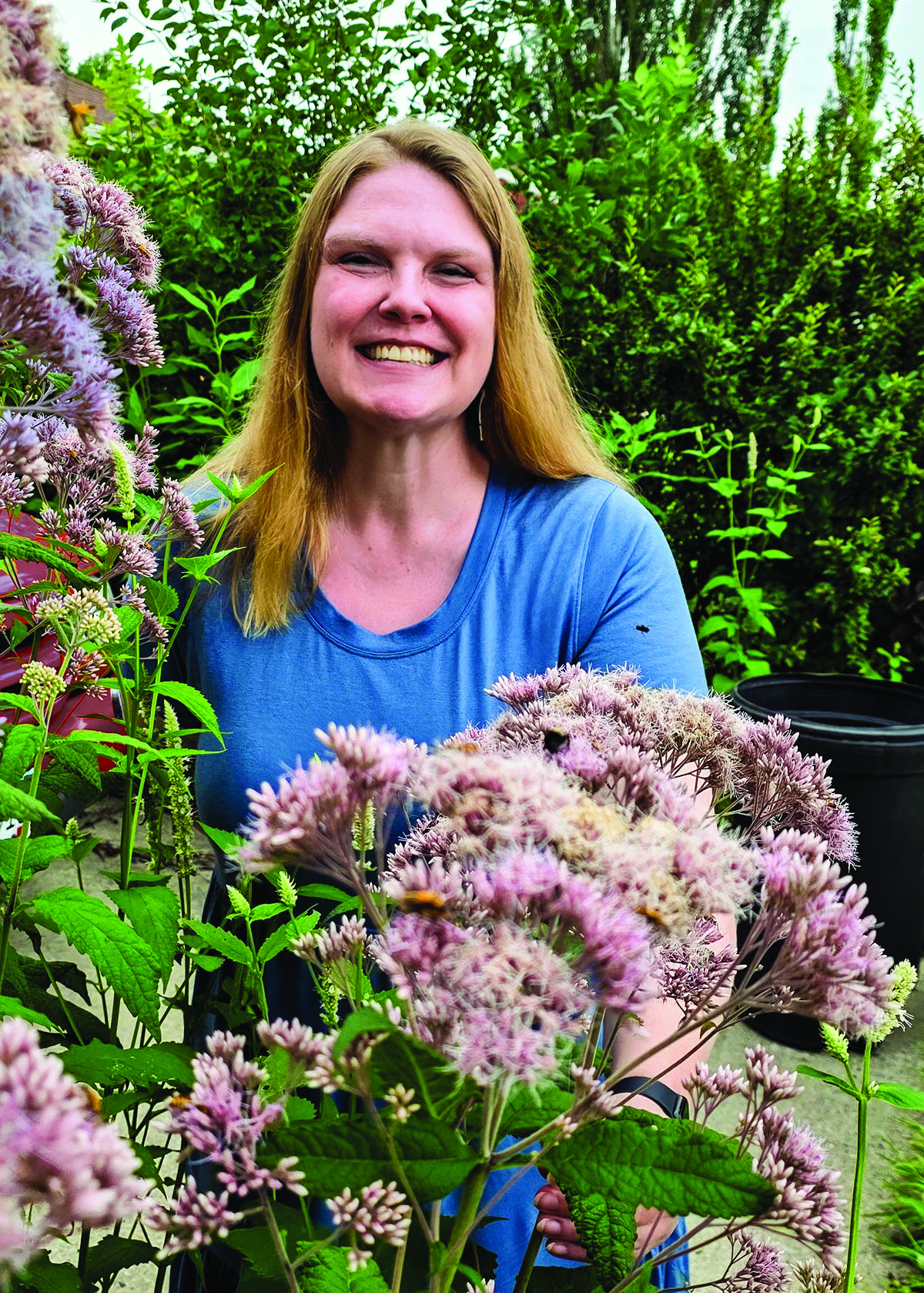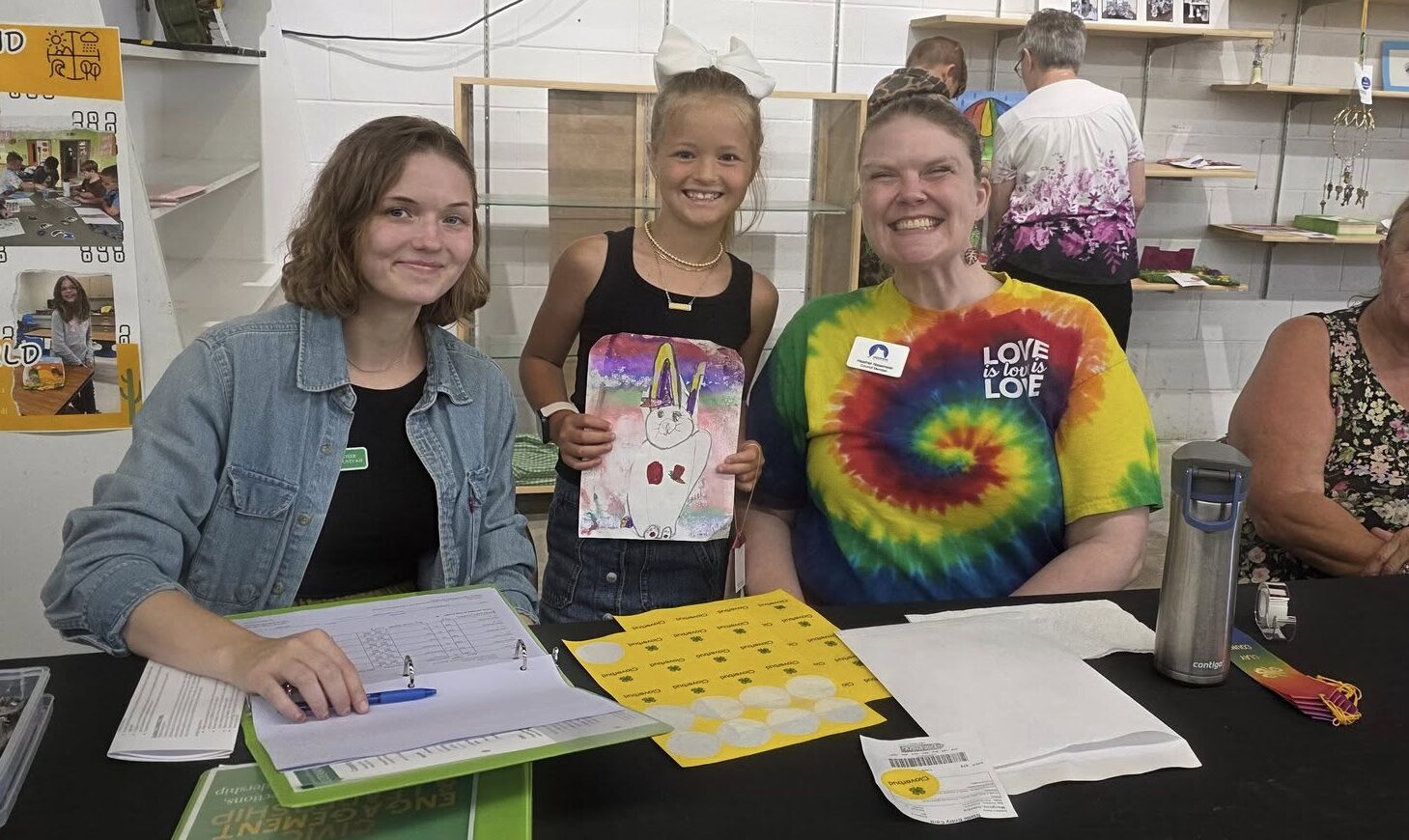
City council member Heather Nesemeier nurtures pollinators in her Ward 2 yard. (Photo/Nancy Hanson.)

A soldier beetle dines on one of the native plants in Heather Nesemeier’s yard. (Photo/Nancy Hanson.)

4-H volunteer judges Heather Nesemeier (right) and Laura Johnson congratulate 7-year-old Greeley Mongeau on her entry in the Clay County Fair’s 4-H contest.
Moorhead City Council
Ward 2’s Nesemeier
Nancy Edmonds Hanson
Getting To Know the Council: This is the seventh in a series of Extra profiles on members of the Moorhead City Council.
Heather Nesemeier never set out to help run Moorhead as a member of its governing council. Today, though, she’s four years into that role, representing Ward 2 – from 11th Street to the eastern border, and from Main Avenue to Interstate 94.
As a volunteer, the 43-year-old Moorhead woman had been involved in a broad spectrum of community activities, ranging from three PB&J School Lunch fundraisers that have raised more than $20,000 to help pay school lunch debt, to expanding the Ellen Hopkins School Nature Play Park, with its food forest and community gardens.
“I’ve had the pleasure of supporting many people who have run for office,” she adds. “So when the opportunity to fill out the application to fill the open seat on the city council, and with the support of former mayor Del Rae Williams and her husband, I decided to try.
“I like to be a catalyst. I know I can’t do it all by myself. If we come together, we can all be catalysts for good … for making a difference in our own community, our nation, our world.”
She was chosen in April 2021 to fill the vacancy created by the election of former Ward 2 rep Shelly Aasen Carlson as mayor, a move necessitated when Mayor Johnathon Judd resigned to accept a seat on the Seventh District judicial bench. Heather was one of six who had applied for the spot. She ran for a full term the next fall and was reelected to her current four-year term.
An advocate for affordable housing and environmental initiatives, she has lived in Moorhead for 10 years. After teaching women’s and gender studies at MSUM both in the classroom and online, she moved to the Office of Online Learning. For the last three-plus years, she has been the administrative assistant to Dean Kyja Kristjansson-Nelson of the College of Arts and Humanities.
“Helping people has been my goal since I was wee,” she recounts. At the age of 5, she was helping parents Rick and Joy Nesemeier serve water and coffee to participants in the 150-mile MS Bike Tour out of a pickup parked near the holiday mall. “M<y parents instilled in me the beauty of sharing your talents to benefit others,” she remembers.
She was always an activist. As a youngster at Carl Ben Eielson Elementary in Fargo, she saw unfairness in after-school play: The boys could play basketball in the gym three days a week. It was reserved for coed play on one afternoon. Girls got just one day a week.
“I wanted to play more,” she says with a smile. She took it up with the principal. The result? More coed play, and another day for the ladies.
Not all wins are so cut and dried. “But small wins are always beneficial, and can lead to bigger victories,” she observes. She cites several close to her heart – regulating the spraying of chemicals to control mosquitoes, and native plants in lawns and boulevards.
She applauds the council’s move five years ago – after the so-called Monarch Massacre – to rethink aerial spraying for mosquitoes, limiting its use and replacing it in most cases with ground spraying. “Now those who don’t want exposure to chemicals can register with the city to suspend spraying on their property,” she points out, noting that aerial application of permethrin imperils beneficial insects along with the pesky biters. “Moorhead has moved discussions of mosquito spraying from the category of a nuisance to a public health matter.” One result: While Vector Control used planes to apply the insecticide last week in Fargo and West Fargo, Moorhead approved only ground spraying.
She endorses the movement to plant pollinator-friendly greenery on boulevards and lawns. “To grow anything other than turf grass on the boulevard, homeowners used to pay a $40 fee and get written permission from all of their neighbors within 250 feet. Turf grass in lawns could only grow to 8 inches. To me, that countered many of the other things we’re trying to foster in our community, like encouraging pollinators,” she recalls. “Now you do still need the permit, but not the permission, for boulevard gardens. Your lawn can be filled with tall grasses and sedges and prairie plants … supporting hundreds and hundreds of every sort of pollinator.”
Heather’s south Moorhead home, which she shares with her husband and 16-year-old son, is an example of that approach. “We have a huge garden. It’s wild,” she reports. “We’ve turned what used to be turf grass into a pocket prairie – a bee lawn.”
Much of her corner lot is an untamed conglomerate of native plants – Joe Pye weed, creeping thyme, violets, clover, self-heal, and much more. Gardens bordering the expanse include tomatoes thriving in straw bales, along with a bevy of herbs: Borage, calendula, rosemary, thyme, catnip, bachelor’s buttons and nasturtiums (both edible plants), and much more.
It’s all part, the council member says, of her city’s response to the Climate Call to Action. “We need a climate response plan for our city, and we’ve made a good start,” she says. “Now we’re being pressed to do more for Minnesota’s GreenStep Cities, where we’ve been rated at level five for several years.” She mentions, too, the Mayor’s Monarch Pledge, a program of the National Wildlife Federation designed to stem the drastic decline of the bright orange butterflies.
The best part of her service on the council, Heather says, is the opportunity to engage with her fellow members and the public to find mutually acceptable answers to the questions that plague every municipality. Until late last year, she had not missed a single meeting. “I was very proud of that. It’s my job to show up,” she says.
But her health intervened. She became sick with symptoms that stymied her doctors. Her colon ruptured and she became septic, necessitating emergency surgery last November. “Finally they told me, ‘We don’t really know what’s wrong with you,’” she says, “and referred me to the Mayo Clinic.” There, she was diagnosed with Idiopathic Myointimal Hyperplasia, a condition so rare that fewer than 50 people in the world are known to have it.
After three surgeries within the space of a year, she says, “I finally feel good. I’m slowly recovering.” She’s participating in research to help learn more about the condition. Despite it all, she’s missed only three council meetings.
The biggest issues facing the council today, she says, are the result of its growing pains. Citing the road construction and other projects endemic to the city, she says, “If it all could be done tomorrow, everyone would be happy. But growth takes time.”
Reach out, she advises the people whom she represents, but please remember that council members are human, too, with jobs and families and limits to the time they’re available for conversation. “When I’ve run to the store on Sunday morning for a missing ingredient for making pancakes is not the time,” she jokes. “I’ll get back to you.
“But please do share what you’re thinking about,” she continues. “I love to hear your ideas. If we can work together, I really do believe that we can accomplish great things.”


